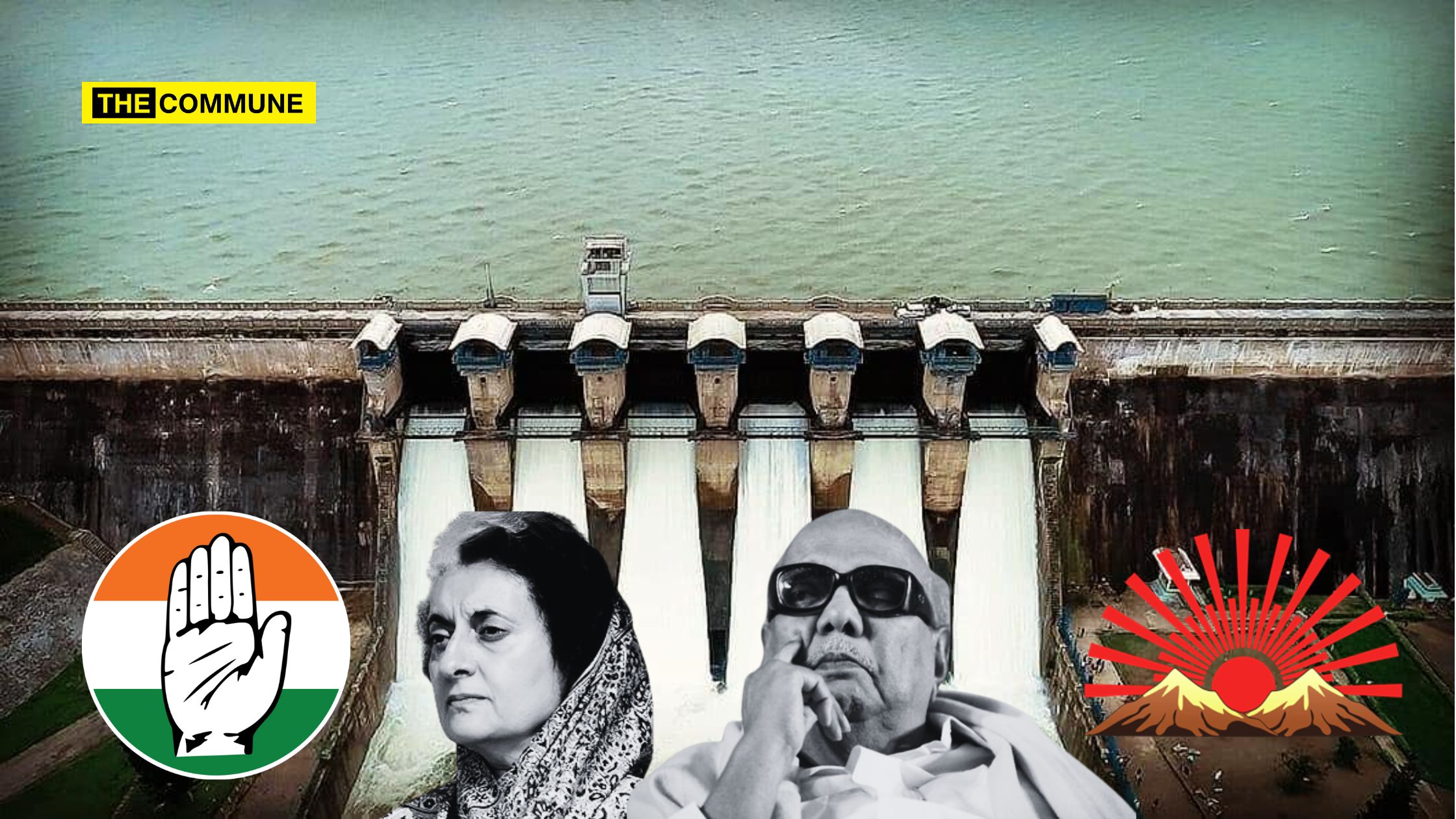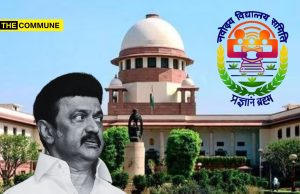
The Cauvery River, flowing through the southern states of Karnataka and Tamil Nadu, has long been a source of contention and conflict over water-sharing. Actors and political parties from both these states would often stage protest. Sometimes the fringe groups indulged in violence in arson. But for the past 4-5 years, the Cauvery was not at all issue between the two states after the constitution of Cauvery Water Management Authority (CWMA). Karnataka would release the mandated cusecs of water to Tamil Nadu as per the Supreme Court orders. Things were smooth when the BJP ruled Karnataka and the Edappadi K. Palaniswami of the AIADMK was in power in Tamil Nadu. But, the Cauvery issue is once again rearing its ugly head. This contentious issue often takes centre stage when the Congress is in power in Karnataka and the Dravida Munnetra Kazhagam (DMK) in Tamil Nadu. The most recent flare-up of the Cauvery dispute is attributed to being sparked by deficient rainfall in the Cauvery basin. But there’s more to it than that meets the eye.
Historical Background
The roots of the Cauvery water dispute can be traced back to the colonial era when the British established a compromise between the princely state of Mysore (now Karnataka) and the presidency of Madras (now Tamil Nadu) in 1924. This agreement allowed Mysore to construct a dam in Kannambadi village to store Cauvery water, with a review scheduled for 50 years later. However, after India gained independence, both states brought the dispute to the Supreme Court multiple times, without achieving a resolution.
The dispute over Cauvery resurfaced before 1974, with Karnataka arguing that under clause XIV of the 1924 agreement, if the Tamil Nadu government built reservoirs on the Cauvery tributaries, Karnataka would be entitled to construct offset storage reservoirs within its jurisdiction. Tamil Nadu had already constructed reservoirs on the Amaravathi and Bhavani. The Hemavathi reservoir’s potential was estimated to be 34 TMCF, and some Mysore leaders argued that if every TMCF of water up to 45 TMCF was not impounded before 1974, Mysore’s control of the water would be permanently lost. The 1892 and 1924 agreements also remained in force, binding Tamil Nadu and Karnataka as successor states to the old Madras Presidency and Mysore state.
What Karunanidhi Did
In the lead-up to the expiration of the agreement, the Tamil Nadu government, led by Karunanidhi, approached the Central government, led by Indira Gandhi, requesting the establishment of a tribunal under the Inter-State River Water Disputes Act, 1956. Despite Karunanidhi’s repeated appeals, Indira Gandhi deferred action until after the Lok Sabha election in March 1971. When no response was received, Tamil Nadu turned to the Supreme Court to request the tribunal’s establishment. Concurrently, the state sought to halt Karnataka’s irrigation projects through a separate petition, which the apex court dismissed. While a fact-finding committee was established by the central government to seek a solution, an all-party meeting in June 1972 led to Karunanidhi government withdrawing its Supreme Court petition in the hopes of an amicable settlement.
However, negotiations became contentious after October 1973, with central government officials appearing more interested in reducing Tamil Nadu’s water allocation. During a meeting in November 1974, Karunanidhi, initially suggesting Tamil Nadu would relinquish 60-80 TMC feet of water, was pressured by the water resources minister to agree to giving up 100 TMC feet, causing shock among Tamil Nadu engineers.
Despite drafting an agreement and convening a meeting in February 1975, the states remained divided. Karunanidhi then called for an all-party meeting and requested the Centre to establish a tribunal. DMK members of Parliament attempted to engage with Indira Gandhi and the president, Fakruddin Ali Ahmed, but were unsuccessful. Karnataka, on the other hand, was unwilling to agree if its irrigation projects were halted.
The dispute continued until 1990 when a group of farmers led by S Rangarajan moved the Supreme Court. The court, in 1990, ordered the establishment of a tribunal led by Justice Chittatosh Mukherjee. In June 1991, the tribunal issued an interim order awarding 205 TMC feet of water to Tamil Nadu.
It’s worth noting that when in power, Karunanidhi managed to release water informally during emergencies and attempted to negotiate with Karnataka’s chief minister in 1997, but no agreement was reached.
Hemavathi Dam Construction
Former Chief Minister M. Karunanidhi faced accusations of betraying Tamil Nadu’s interests on the Cauvery issue due to withdrawing a Supreme Court petition in 1972. The state initially filed the suit in 1971 but withdrew it a year later based on Prime Minister Indira Gandhi’s assurance of resolving the dispute through negotiations.
Karunanidhi endured criticism for compromising the state’s rights, with the suit withdrawal cited as the reason for Tamil Nadu’s water-sharing woes with Karnataka. However, S. Ranganathan, whose 1983 petition led to the Cauvery Water Disputes Tribunal (CWDT), asserts that Karunanidhi did not abandon the state. The decision to withdraw the suit included reserving the right to return to court if necessary.
Ranganathan conveyed this to Karunanidhi’s rival, Jayalalithaa, who had criticized the move. Nevertheless, Ranganathan noted that the DMK government under Karunanidhi from 2006-11 was sluggish in publishing the CWDT’s final order in the Central government gazette. Jayalalithaa ultimately got this done.
Before the agreement could expire, the Tamil Nadu government, then led by Karunanidhi, approached the central government headed by Indira Gandhi, requesting the establishment of a tribunal under the Inter-State River Water Disputes Act of 1956. In December 1970, Karunanidhi wrote to Gandhi, expressing the state’s need for a tribunal due to recurring water-sharing disputes. Gandhi responded, indicating that no action would be taken until after the Lok Sabha elections in March 1971. After the parliamentary elections, Karunanidhi sent two reminders. However, during this period, he informed the state assembly that his government had no objections to Karnataka’s construction of the Hemavathi dam.
Jayalalithaa Enlists 4 Betrayals Of Karunanidhi
Restating her stand on the Cauvery water dispute, the then AIADMK general secretary J Jayalalithaa asserted (in 2010) that she advocated for the establishment of a Cauvery Water Authority consisting of officials. She also accused Chief Minister M. Karunanidhi of acting against the best interests of Tamil Nadu. She enlisted 4 betrayals of Karunanidhi.
- First Betrayal: Karunanidhi initially claimed to have written to the Centre for a tribunal in 1970, but later stated in the Assembly that Tamil Nadu had no objection to a dam across Hemavathi.
- Second Betrayal: Karnataka began constructing dams on other Cauvery tributaries (Kabini, Harangi, and Sornavathi) without proper approvals. Karunanidhi remained silent, marking a second betrayal.
- Third Betrayal: Karunanidhi withdrew a case filed by the State government in the Supreme Court under political pressure. This move was seen as the third betrayal.
- Fourth Betrayal: Failure to revive the 1974 agreement between the Madras Presidency and Mysore Samathan, despite being in power, constituted the fourth betrayal. The agreement, originally signed in 1892 and reaffirmed in 1924, should have been reinstated in 1974 during the DMK’s tenure.
What The Congress Did
Throughout the years, Congress leaders, both at the national and state levels, have consistently failed to resolve the Cauvery River water dispute. This includes prominent figures like Indira Gandhi, P V Narasimha Rao, Manmohan Singh, as well as chief ministers such as Veerendra Patil, Devraj Urs, and Siddaramaiah. They have all favored discussions over tribunals but have not been successful in settling the dispute.
In 1991, when the Cauvery Water Tribunal issued its interim award, Karnataka’s chief ministers at the time, S Bangarappa and Veerappa Moily, failed to implement it. Despite Jayalalithaa’s indefinite fast in 1993 demanding its implementation, the Congress-led central government, under Prime Minister Rao, did not ensure compliance.
The dispute resurfaced in 1995 due to monsoon failures, with Tamil Nadu seeking 30 TMC of water, but the tribunal recommended only 11 TMC. Once again, the Congress let down Tamil Nadu, with Rao’s government urging Karnataka to release only 6 TMC of water. It took significant effort from Rao to persuade Karnataka to release this amount.
In 2002, tensions escalated when Karnataka refused to release water to Tamil Nadu due to rainfall shortages. Jayalalithaa approached the Supreme Court, and then Karnataka Chief Minister S M Krishna had to take a peace walk to ease tensions.
In 2007, the Cauvery Water Dispute Tribunal announced its final award, but both Tamil Nadu and Karnataka rejected it.
In 2013, the Manmohan Singh government notified the final award but did not establish the Cauvery Water Board as mandated by the Supreme Court. The Congress government in Karnataka, led by Siddaramaiah, refused to release water to Tamil Nadu despite a Supreme Court order, leading to riots and conflicts.
The Congress government also failed to establish a permanent Cauvery Management Board and opposed the setting up of a tribunal when the Supreme Court issued its final ruling in 2018, allocating additional water to Karnataka for drinking purposes.
Today, the Congress government in Karnataka is politicking with the Cauvery issue. Why can’t Siddaramaiah convince his ally MK Stalin to understand the grim situation in Karnataka due to less rains in the catchment areas?
The Cauvery Water Disputes Tribunal (CWDT)
In 1990, recognizing the need for a more structured approach to resolving the ongoing conflict, the Indian government led by VP Singh established the Cauvery Water Disputes Tribunal (CWDT) as directed by the Supreme Court. The tribunal’s purpose was to adjudicate disputes related to the sharing of Cauvery River water among Karnataka, Tamil Nadu, Kerala, and Puducherry.
The CWDT issued temporary directives, mandating Karnataka to release a specific volume of water to Tamil Nadu on a monthly or weekly basis. These directives were intended to address the immediate needs of both states but did not provide a comprehensive solution.
The 2018 Supreme Court Verdict
The Cauvery dispute reached a significant milestone in 2018 when the Supreme Court issued a verdict that aimed to provide a final resolution to the long-standing conflict. The court granted an additional water share to Karnataka for drinking water purposes in south Karnataka while reducing Tamil Nadu’s share by the same amount. This verdict was welcomed as a step towards ending the protracted dispute.
The Current Crisis
The recent resurgence of the Cauvery dispute can be attributed to a combination of factors, primarily deficient rainfall in the Cauvery basin. The monsoon season in Karnataka has been marked by exceptionally low rainfall, leading to a water scarcity crisis. As a result, the four major reservoirs in the Cauvery basin—Krishna Raja Sagar, Kabini, Hemavathy, and Harangi—have seen their storage levels drop significantly.
Under the 2018 Supreme Court order, Karnataka is obligated to release a specific volume of water to Tamil Nadu between June and September. However, the crisis brought about by the monsoon deficiency has complicated matters. Karnataka has argued that releasing water to Tamil Nadu during a water scarcity crisis would be detrimental to its interests.
The Cauvery Water Management Authority (CWMA)
The Cauvery Water Management Authority (CWMA) was established to oversee the implementation of the 2018 Supreme Court orders and monitor the sharing of Cauvery River water between the two states. The CWMA’s primary responsibility is to ensure compliance with the court’s directives and address any disputes that may arise.
In August 2021, the CWMA issued a directive instructing Karnataka to release 5,000 cusecs of water to Tamil Nadu for 15 days. This directive was met with resistance from Karnataka, which contested the decision. However, the Supreme Court upheld the CWMA’s directive, ordering Karnataka to comply with the release of water.
The Dravidian Parties Are To Blame For The Cauvery Crisis
The unlawful extraction of river sand has led to a decline in groundwater levels within the state, resulting in the drying up of wells throughout the Cauvery delta region. Widespread sand mining, primarily driven by the real estate sector, has caused the water table to drop below 100 meters in many areas. Interestingly, this has had a more adverse impact on agriculture than the actual reduction in water availability during periods of drought.
It is worth noting that since 1967, when the DMK came to power in Tamil Nadu, the state has only undertaken a limited number of water storage projects. In contrast, Karnataka has constructed 26 reservoirs along the Cauvery river during the same period, while Tamil Nadu has completed only 13. This raises the question of why Tamil Nadu, which heavily relies on Karnataka for its agricultural water needs, has not invested in more check dams or smaller reservoirs, especially when neighboring Andhra Pradesh has successfully constructed 25 check dams spanning 45 kilometers along the Palar river, which also feeds into Tamil Nadu.
This situation reflects a significant failure on the part of both the AIADMK and DMK governments, as they have failed to take proactive measures to preserve and manage water resources effectively.
The Bengaluru Bandh And Protests
The contentious release of Cauvery River water to Tamil Nadu has triggered protests and unrest in Karnataka. Several pro-Kannada organisations, farmer groups, and labour unions, with the support of the opposition Bharatiya Janata Party (BJP) and Janata Dal-Secular (JDS), called for a bandh (shutdown) in Bengaluru. The protesters are demanding that the Karnataka government cease the release of Cauvery reservoir waters to Tamil Nadu until the CWMA reviews the situation.
This protest movement highlights the emotive nature of the Cauvery dispute and its ability to mobilize political forces in Karnataka. In the past, the issue has resulted in violence, with mainstream political parties trying to gain support by taking chauvinistic positions. However, recent years have seen politicians in Karnataka adopt a more conciliatory approach, recognizing the evolving demographics of the state and shifting priorities away from agriculture.
Owing to lack of Cauvery water in Tamil Nadu, crops are dying. A farmer in Nagapattinam also died allegedly of a heart attack as he had taken loans and the crop failure.
The Cauvery water dispute is a recurring challenge in the southern states of Karnataka and Tamil Nadu, often exacerbated by political dynamics, climate variability, and differing perspectives on equitable water allocation. With the SC refusing to intervene, the onus is on the ruling governments in both the states who are also part of the I.N.D.I. Alliance to sort out the matter amicably. It’s worth noting that when the BJP governed Karnataka, negotiations were relatively smooth and peaceful. Therefore, calling for the centre to intervene when there is a Supreme Court order in place and when it is the alliance partners who are in charge is ludicrous.
Click here to subscribe to The Commune on Telegram and get the best stories of the day delivered to you personally.




